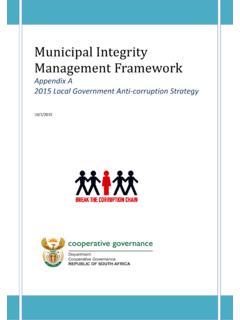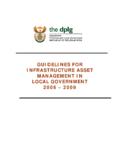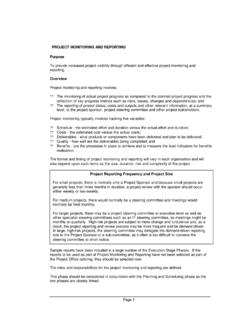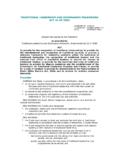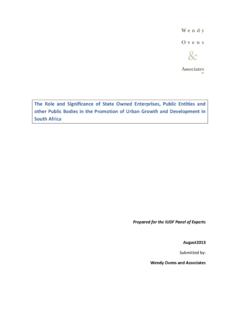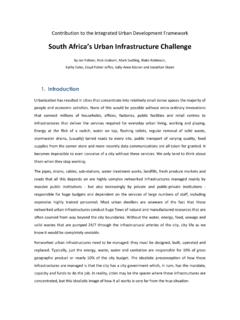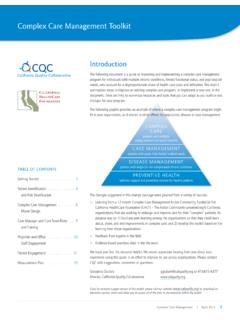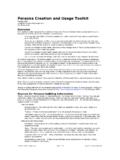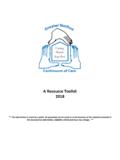Transcription of ASSUMPTION MANAGEMENT Purpose Overview
1 ASSUMPTION MANAGEMENT Page 1 ASSUMPTION MANAGEMENT Purpose To provide a procedure and associated guidelines to facilitate the MANAGEMENT of project-related assumptions made both before and during the project. Overview An ASSUMPTION can be defined as a statement of belief concerning the outcome of a future event, , they arise from an element of uncertainty. assumptions are factors that, initially for project planning purposes, are assumed to be true, real or certain. assumptions should be based as much on fact as is reasonably possible at the time that the ASSUMPTION is made.
2 It is vital that areas of uncertainty are recorded and the accuracy of the ASSUMPTION is increased as more data becomes available. assumptions generally involve a degree of risk and thus may also be reflected in the Risk Log maintained in Risk MANAGEMENT phase. During the early phases of a project, a number of assumptions may be made in three specific areas: ??The development and contents of the business case ; ??The development of the project scope; or ??The development and ongoing maintenance of the project schedule. It is necessary to track assumptions to assess their impact on the project and to track their MANAGEMENT to be able to challenge them and to develop contingency plans should they prove to be invalid.
3 Estimating assumptions are unique to each project and should be documented. They may include factors such as transaction counts, estimates of the number of database fields, tables and record volumes, numbers of users, network traffic patterns, volumes and capacity needs. These and other calculations will be used to assist in the generation of project estimates. assumptions and Constraints assumptions are forecasts about what may happen in the future, while constraints are limits on freedom of choice. A formal definition of a constraint is the state of being restricted or confined within prescribed bounds (Source: The American Heritage Dictionary of the English Language, Fourth Edition).
4 When determining assumptions , it may be important to consider any project-related constraints as they may drive the identification of further assumptions . For example, assumptions may determine the scope of a project whilst constraints may reflect the assumed business and technology context such as any existing organisational agreements for the supply of certain types of technology components from one supplier ( We only use computer hardware from company X ). This may impact the project by restricting the choice of available technology components thus leading to an ASSUMPTION such as It is assumed that all computer hardware devices will be acquired from company X.
5 ASSUMPTION MANAGEMENT Page 2 If during the project, any of these estimating assumptions prove to be invalid and impact the project plan, the Project Manager can use scope change mechanisms to revise the plan based on the new or amended assumptions . The objectives of this Phase include: ??Providing a standard means for recording assumptions and how they were derived; ??Determining the ownership of the assumptions ; ??Evaluating the stability of and impact on the project if any of the assumptions prove to be true or false; ??Defining the actions necessary to progress and monitor the assumptions ; ?
6 ?Making provisions for conflicting assumptions ; and ??Scheduling when assumptions are to be validated and reviewed throughout the life of the project as well as after the project ends where the assumptions may affect the post-project benefits realisation process. ASSUMPTION MANAGEMENT Page 3 Summary Inputs Policy Documents Business Strategies Project Definition Document Budgets Business case Risk Log Dependency Log assumptions Project Plans, Estimates and Costs Performance Measures or Estimates Resource Estimates Procedure Documents Tasks Define ASSUMPTION MANAGEMENT Process, Roles and Responsibilities Implement ASSUMPTION MANAGEMENT Process.
7 Roles and Responsibilities Identify and Manage assumptions and Prepare ASSUMPTION MANAGEMENT Reports Interim work products ASSUMPTION MANAGEMENT Reporting Requirements ASSUMPTION MANAGEMENT System Requirements ASSUMPTION MANAGEMENT Guidance and Training Phase deliverables ASSUMPTION Log ASSUMPTION Form ASSUMPTION MANAGEMENT Process Flow ASSUMPTION MANAGEMENT Procedure ASSUMPTION MANAGEMENT Roles and Responsibilities ASSUMPTION MANAGEMENT System Implemented ASSUMPTION MANAGEMENT Process, Roles and Responsibilities New ASSUMPTION Form ASSUMPTION Log (Updated) Project Plans (Updated) New Risk Identification Form Risk Log (Updated) Business case (Updated) Benefits Log (Update)
8 ASSUMPTION MANAGEMENT Reports Reference materials ASSUMPTION Log ASSUMPTION Form ASSUMPTION MANAGEMENT Task/Responsibility Matrix ASSUMPTION MANAGEMENT Page 4 ASSUMPTION MANAGEMENT phase F1 Define ASSUMPTION MANAGEMENT Process, Roles and Responsibilities F2 Implement ASSUMPTION MANAGEMENT Process, Roles and Responsibilities Policy Documents Business Strategies Project Definition Document Budgets Business case Risk Log Dependency Log assumptions Project Plans, Estimates and Costs Performance Measures or Estimates Resource Estimates Procedure Documents ASSUMPTION MANAGEMENT Reporting Requirements ASSUMPTION MANAGEMENT System Requirements ASSUMPTION Log ASSUMPTION Form ASSUMPTION MANAGEMENT Process Flow ASSUMPTION MANAGEMENT Procedure ASSUMPTION MANAGEMENT Roles and Responsibilities ASSUMPTION MANAGEMENT System ASSUMPTION MANAGEMENT Guidance and Training Implemented ASSUMPTION MANAGEMENT Process.
9 Roles and Responsibilities F3 Identify and Manage assumptions and Prepare ASSUMPTION MANAGEMENT Reports assumptions Project Plans New ASSUMPTION Form ASSUMPTION Log (Updated) Project Plans (Updated) New Risk Identification Form Risk Log (Updated) Business case (Updated) Benefits Log (Update) ASSUMPTION MANAGEMENT Reports ASSUMPTION MANAGEMENT Page 5 1 Define ASSUMPTION MANAGEMENT Process, Roles and Responsibilities Purpose To define the ASSUMPTION MANAGEMENT procedures, roles and responsibilities and to prepare supporting forms and systems. Overview This task is used to define the process that is to be used to identify, evaluate, prioritise, assign, review and manage assumptions .
10 The associated roles and responsibilities are defined and agreed. An ASSUMPTION Form and ASSUMPTION Log are created. Where an ASSUMPTION MANAGEMENT system is to be used, the requirements are defined, any system components are purchased, installed and tested or the ASSUMPTION MANAGEMENT system is built and tested. Determine how project assumptions are to be identified. Determine how project assumptions are to be identified. Review documents produced before or early in the project such as: ??Project Definition Document; ??Business case ; ??
![Disaster Management Act [No. 57 of 2002]](/cache/preview/e/5/d/2/b/3/6/7/thumb-e5d2b36743b64ebe9204d7e874f734ad.jpg)
